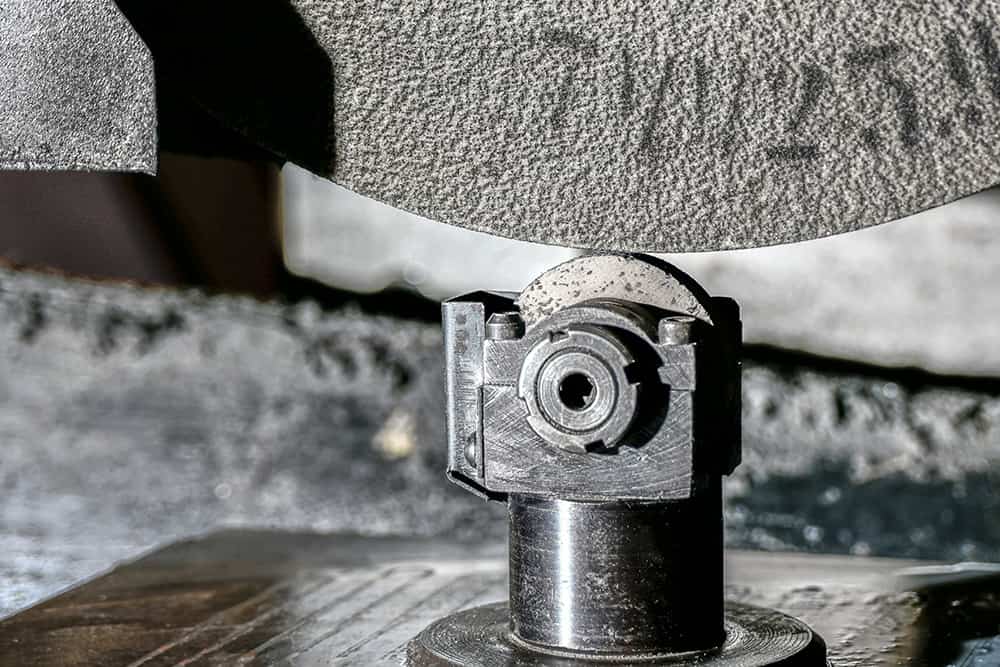
Grinding wheels, also known as abrasive wheels, are powerful cutting tools that need to be handled and maintained properly. If grinding wheels are used incorrectly or are not kept in top condition, they can break and cause serious injuries or even fatalities.
Dressing is an important part of preparing new grinding wheels for use, as well as maintaining older grinding wheels. If a grinding wheel is not dressed, it will not cut as effectively or as precisely. This can result in poor-quality work and may also endanger the safety of both the operator and anyone in the near vicinity.
In this article, we will go over why there is a need to dress grinding wheels, the types of grinding wheel dressings, what types of tools are required and provide a short guide on how to dress a grinding wheel.
Why Do You Need to Dress a Grinding Wheel?
Figures gathered by the Health and Safety Executive (HSE) have shown that almost half of all injuries related to the use of grinding wheels were due to unsafe work practices or operator error. All operators should know how to dress a grinding wheel and be aware of why it is necessary to do so, as well as when it should be done.
Just as with any cutting tool, a grinding wheel dulls after repeated use. Rather than replace the wheel, the operator can dress it to get rid of any old, dull grains and remove any clogs or excess amounts of bonding material. Dressing of a grinding wheel ensures that it stays sharp, cuts precisely and maintain its shape.
Types of Dressing for Grinding Wheels
As well as dressing old grinding wheels, operators must also dress new wheels before they can be used safely.
Truing is the process of preparing a new grinding wheel by dressing it.
Truing:
- Eliminates any manufacturing eccentricities, such as high or uneven areas
- Should be done as soon as the wheel has been installed, to ensure an undressed wheel is never used
- Ensures that the grain of a new wheel is sharp and not smooth
- Removes any runout from its surface and forms the wheel into the desired shape
Standard dressing is the process of dressing an older wheel.
Standard dressing:
- Removes bond material and fractures sub-abrasive grit
- Ensures the wheel maintains a sharp edge
- Can be done at any time during the lifespan of a grinding wheel.
- Should be done when the wheel has become worn or dirty, or it has become dull due to use.
What is a Grinding Wheel Dresser?
A grinding wheel dresser is a tool used to dress grinding wheels. These tools fall into two main categories:
- Stationary diamond dressing tools
- Rotary diamond dressing tools
Stationary Diamond Dressing Tools
Stationary diamond dressing tools include:
- Single-point cone tools with a single-stone diamond are used for complex forms and radius dressing work. These tools must be rotated at speed to be effective
- Blade tools with numerous natural or synthetic pieces of diamond in the blade tip. Blade tools are also used for complex forms and radius dressing work but do not need to be rotated
- Multi-point tools have numerous smaller diamonds in the tip. These tools are only used for taper or straight dressing
Stationary diamond dressing tools are flexible, take a long time to complete the dressing process and have a short diamond lifespan.

Rotary Diamond Dressing Tools
Rotary diamond dressing tools include:
- Rotary dressing diamond discs with diamonds in the outside diameter. The rotary disc is used to shape a grinding wheel into a wheel form. Rotary dressing discs are also flexible, take a shorter time to complete the dressing process and have a longer diamond lifespan.
- Rotary dressing diamond rolls can be shaped to fit the desired form of the grinding wheel and are then put into the grinding wheel to dress it. Rotary diamond rolls can complete a dressing in a short time and have a long diamond lifespan but can only work with fixed shapes.
How to Dress a Grinding Wheel - Six Steps
When dressing a grinding wheel, there are six steps that should be followed:
- Step One: Make sure you use the correct dressing tool for the wheel. The grit of the tool should be two sizes finer than the grit of the wheel. Use a tool with the right shape for your wheel
- Step Two: Switch off the coolant pump, if the grinding machine is equipped with one
- Step Three: Activate the grinding machine and let it reach full power (RPM). If the wheel requires a large amount of truing it may be better to leave the machine on
- Step Four: Apply the dressing tool to the grinding wheel’s abrasive area using light to medium pressure. Continue the pressure until the wheel stops rotating
- Step Five: Repeat the last step until the wheel starts to pull the tool away
- Step Six: Steps four and five are to be repeated as necessary
Utmost care must be taken when dressing a grinding wheel. The tool rest must be kept away from the wheel to avoid injury to the operator and damage to the equipment. Protective clothing such as safety glasses should be worn and all loose clothing and long hair should be kept pulled back.
Health and Safety Training for Grinding Wheels
The operation of grinding wheels must be compliant with guidelines outlined under the Provision and Use of Work Equipment Regulations 1998 (PUWER). Grinding wheels must only be used and maintained by competent persons who have received appropriate training.
Human Focus offers online training for grinding wheel machine operators. The Human Focus Abrasive Wheels courses give participants a full understanding of all health and safety principles involved in operating grinding wheels. These courses are approved by relevant authorities and can be taken in segments at your convenience.






















































































































































































































































































































































































































































































































































